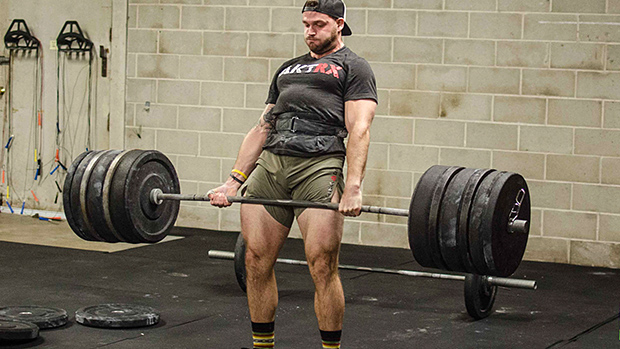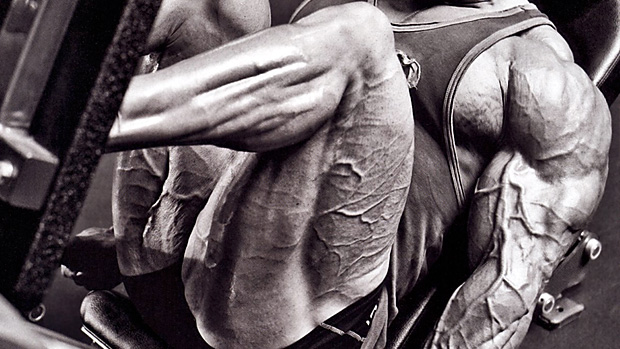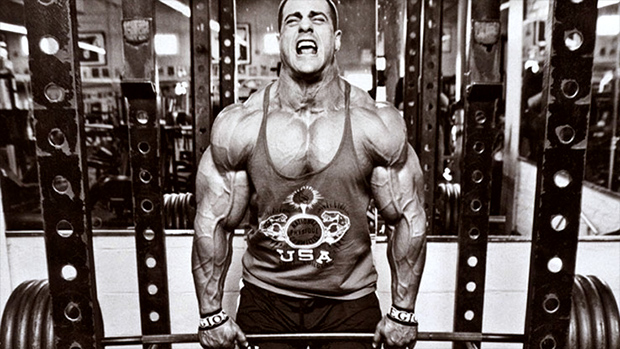I've always preferred to read books written by (or about) strongmen and weightlifters from the early 1900s to the '60s. Back then, they didn't have the Internet or any pre-formed lifting dogma; everybody who trained with weights was basically left to themselves.
They found out what worked and what didn't through experimentation. They weren't inhibited by any pre-conception or fear of going against the grain. They tried everything. If it worked, they kept it. If it didn't work, they dropped it.

There's a reason this isn't the most popular exercise in your gym.
A lot of times, people today are afraid of trying something different, because they're afraid of looking foolish in the eyes of others, or because they have pre-conceived notions that prevent experimentation and learning. This article will deal with something you might have been considering for a while, but always refrained from experimenting with... the deadlift and its variations!
Why isn't it more often used in gyms? Well, if it's even "allowed" at your gym, most guys don't include it because if they even bother to train their lower body at all, they stick with a few sets of leg extensions (after a 20-set biceps workout). Also, deadlifts are hard work.
And that's a sad thing, because a training program based around deadlifting is the best way to completely transform your physique in record time.
Another perceived weak point to the deadlift is that, while it's a very good overall mass builder, it's kinda hard to efficiently target certain problem areas. When you're lifting a weight, your body doesn't know that you are trying to build a specific muscle group; it only knows that it's fighting a heavy-ass weight (which could very well be a live opponent) and if you don't win, you might die on the field of battle!
So in the interest of survival, your body makes use of the muscles best suited to do the job. These muscles (the stronger ones) will receive the most stimulation and thus grow the most. For that reason, deadlifts are often seen as a good overall size and strength builder, but not a good movement to build an aesthetic physique.
But nothing could be further from the truth!
With slight adjustments in pulling style, grip width, foot placement, and range of motion, you can modify the muscle emphasis of the deadlift. Here are some variations, and the muscles they emphasize.
The Basic Deadlifts
1 – Romanian Deadlift
This exercise is designed to focus on the hamstrings, glutes, and lower back – the whole posterior chain. Contrary to most other deadlifts, you don't start with the bar on the ground, but from what could be considered the "finish" position, standing upright with the bar in your hands.
From that position, lower the bar to below the knees, while keeping the knees slightly bent at the same angle as in the starting position. You do so by bending forward at the hips, and most importantly, by bringing your hips back as far as possible. Imagine trying to touch a wall that is a few feet behind you.

From the lower position, lift the bar back up by bringing the hips forward while squeezing the glutes. To maximize hamstrings recruitment, make sure to really bring those hips back. Remember that the more a muscle is being stretched prior to being contracted, the more it's recruited.
To further increase hamstrings activation, you can perform the exercise with the front of your feet elevated, with the toes on a five or ten-pound plate.
2 – Conventional Powerlifting Deadlift
In this variation, the best known of all, everything is designed technique-wise to maximize the amount of weight lifted. The hips start higher than the knees (basically putting the knees at the same angle as a quarter squat) and the shoulders are slightly behind the bar in the starting position. This allows you to make maximum use of the lower back, glutes, and quads.
For example, we're stronger in a quarter squat than a full squat. Starting the deadlift with the knees in a quarter squat position right away put the quads in a mechanically-advantageous position. The quarter squat position also puts more emphasis on the vastus medialis (the portion of the quadriceps right next to the kneecap) because this part of the quad is responsible for the last degrees of extension, as well as knee stabilization.
The lower back is heavily involved because of the flatter torso angle. The higher the hips are in the starting position, the closer to parallel (to the ground) the torso will be. This obviously involves the lower back quite a lot.

Having the shoulders behind the bar facilitates a pulling motion that shouldn't be straight up, but up and backwards (pulling the bar towards you and up at the same time). This would involve the hamstrings or glutes more. But because of the hip position, the glutes will tend to work harder.
As you can see, there really is no specific emphasis in this movement. Everything is worked to some extent, and this makes it a great foundational exercise.
3 – Clean-Style Deadlift
This is the type of deadlift used by Olympic lifters to strengthen their pulling strength while transferring these gains to the competitive clean and jerk. To the untrained eye, it does resemble a conventional powerlifting deadlift, however, there are differences, which do change the muscle emphasis.
The first difference is hip height. The hips are lower in the Olympic (clean-style) deadlift. This means that the knees are more bent; closer to a half squat than a quarter squat. The torso is also more upright. Finally, the shoulders are either above the bar or slightly in front of it.

These differences decrease the load on the lower back slightly, but it also strengthens the obliques and transverse abdominus more than a powerlifting deadlift, because of the core strength needed to maintain an upright position during the first phase of the pull. During that first phase of the pull (taking the bar from the floor to above knees), it's crucial to maintain the same trunk angle.
This type of pulling naturally puts more emphasis on the quads and glutes, and less on the hamstrings and lower back. These muscles still get some work, but not as much as during a powerlifting deadlift. Also, since the quadriceps participate to a greater portion of the range of motion, it is a better overall builder of the quads than the powerlifting deadlift.
4 – Snatch-Grip Deadlift
This is another movement used by Olympic lifters. The main difference between the clean-grip deadlift and the snatch-grip deadlift is... surprise, surprise... the grip width. The snatch-grip is noticeably wider. The width of the grip should be from the tip of the fingers of your extended arm to the tip of the opposite shoulder.
The extreme grip forces you to squat down even lower than in a clean-grip deadlift, almost into a full squat position. This obviously means an even steeper torso angle. Remember that the torso angle should not change during the first pull! Imagine pushing yourself into the ground, instead of lifting the bar.
As we saw earlier, the lower the hips are, and the more upright the torso is, the more the quads and glutes will do the work and the less the lower back will be involved. In that sense, the snatch-grip deadlift is just as effective as a squat for building the quads and glutes.

An added benefit is the recruitment of the upper back. The wider grip makes your upper back and rear delts work extra hard to keep the bar in the proper position (close to the body), especially during the eccentric portion of the exercise. For that reason, the snatch-grip deadlift is a fantastic lower body and posture builder.
5 – Snatch-Grip Deadlift from a Deficit
Everything is performed exactly the same way as the snatch-grip deadlift. The only difference is that you're doing the exercise while standing on a podium (or a pair of 25-pound plates). You could also just load the bar with smaller plates.

This increases the range of motion so to properly do the exercise, you're forced to squat down even lower into the starting position. This will further increase quadriceps and glutes activation. In my opinion, this is the ultimate lower body shaping exercise.
The Specialty Deadlifts
6 – Sumo Deadlift
Despite the name, the sumo deadlift won't turn you into a 700-pound mammoth with bad taste in clothing and hairstyles! What it will do, is give those glutes and inner thighs a fantastic workout.
Take a wide stance (around twice as wide as in the five deadlift variations listed above) and grip the bar inside your legs, with a grip that is shoulder-width or slightly narrower. The width of your feet will have much of the same impact as the width of the grip in a snatch-grip deadlift: it forces you to squat down lower to take a proper and safe pulling position.

The wider foot position reduces the involvement of the lower back while putting more emphasis on other muscle groups. In this case, it's the glutes. Remember, the muscle that's stretched the most is the muscle that's recruited the most!
Because of the stance width the hips will be low – the glutes are stretched – but the knee angle won't be as pronounced as in a snatch-grip deadlift. The result is even more emphasis on the glutes. The width of the stance also favors the inner portion of the thigh, due to the pulling line of the lower body.
7 – Curl-Grip Deadlift
This variation of the deadlift is essentially the same as a clean-grip deadlift, but you hold the bar with a ''curl'' grip (supinated). In the starting position, the palms of your hands will be facing forward.

This slight change will have a very significant benefit. It will strengthen the external shoulder rotators and reinforce perfect posture. Obviously, to do so, you must make an effort to keep the bar close to you at all times, and keep your shoulders pulled back. Think, 'beach position!'
The rest of the benefits are the same as with the clean-grip deadlift, but since you're likely to use less weight, the impact on lower body development won't be as important as with other types of deadlifts.
8 – Duck-Feet Clean-Grip Deadlift
This one is a staple of Chinese Olympic lifters – the strongest lifters in the smaller weight classes and women's lifting. It's mostly because this is the way they do their cleans and snatches. The heels are together (or close to together) in the starting position, with the feet turned out 45 degrees.

Feet close, toes out.
This variation of the clean-grip deadlift is better than the original for building the quadriceps. The lower leg angle allows you to keep the bar closer to the body, because the knees aren't in the way, which decreases the involvement of the lower back. However, it does put less emphasis on the glutes.
9 – Duck-Feet Snatch-Grip Deadlift
Nothing much to say here.It's just like a snatch-grip deadlift, but with more emphasis on the quads and less on the glutes. I'd say that this movement, or this movement performed from a deficit, is the best quadriceps exercise in existence... besides, maybe, the front squat.

Feet close, toes out, hands wide.
10 – The ''Original'' Good Morning
Today, we know the good morning as an exercise where you hold the bar on the upper back, and bend forward, in a motion that's basically the same as a Romanian deadlift. But the original good morning exercise, which dates back to the early 1900s, is quite different.
It's similar to a Romanian deadlift, but the bar starts on the floor. The bar is close to the shins, the hips are very high (about as high, or higher, than in a conventional powerlifting deadlift) and the arms are fully extended.
From that position, lift the bar overhead in one smooth motion, while keeping your arms extended. In the finish position, you look like you completed a shoulder press.

This is a challenging movement, and one that I recommend only if it can be performed without rounding the lower back. Very light weights have to be used. This movement is a very good upper back, rear deltoid, rhomboid, and lower back builder. As such, it's an interesting postural movement.
It can also be used as a light warm-up for other deadlift movements. Remember this is not a swing or snatch. The movement should be performed under control, not explosively.
The Other Deadlifts
You've already learned more than enough to design a complete, and very effective, long-term program. However, if you still want more variety, here's a short list of other options.
- The barbell hack squat (or behind-the-back deadlift) is possible, but it's hard to do if you have a long torso and/or short arms.
- The trap bar deadlift is a great alternative to the squat. The only problem is that you need to have a trap bar to do this movement!
- The deadlift-into-shrug can be done with any traditional form of deadlift. Simply shrug the bar up at the end of the movement, to involve the traps more.
- The single-leg deadlift is a decent unilateral posterior chain movement.
The 4 Laws of Safe Deadlifting
- Never, ever, let the lower back round at any time during the movement. The lower back should be arched to minimize injury risk and maximize force transfer between the upper and lower body.
- Think 'beach position.' You know, when you strut your stuff on the beach to impress others. Shoulders are pulled back, chest held high, abs tight. That's how you should perform a deadlift!
- Do not use a mixed grip (one hand supinated, one hand pronated). When you're lifting for record weights, you don't have much choice. When you're deadlifting to improve your body, you want to avoid any chance of creating imbalances.
- Don't hyperextend the neck. You shouldn't be looking down, but hyperextending the neck is no better because it can cause neck injuries. Try to keep the spine neutral, or slightly extended, at the neck.
Wrap-up
The deadlift could be the king of body transformation exercises! If you select the variation(s) that best suits your needs, it's one of the fastest ways to get results when it comes to muscular development and fat loss. In fact, I have many of my clients use up to four deadlift variations per week (on separate days). As the saying goes: if it's good, use it... a lot!





